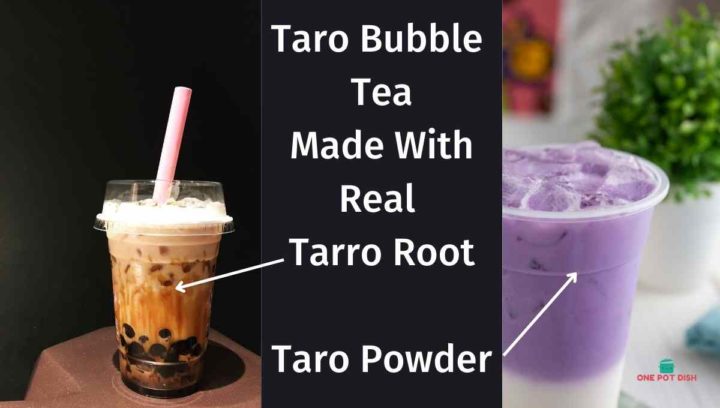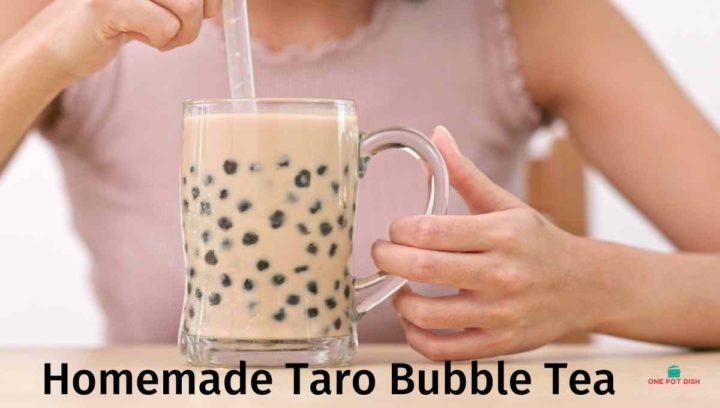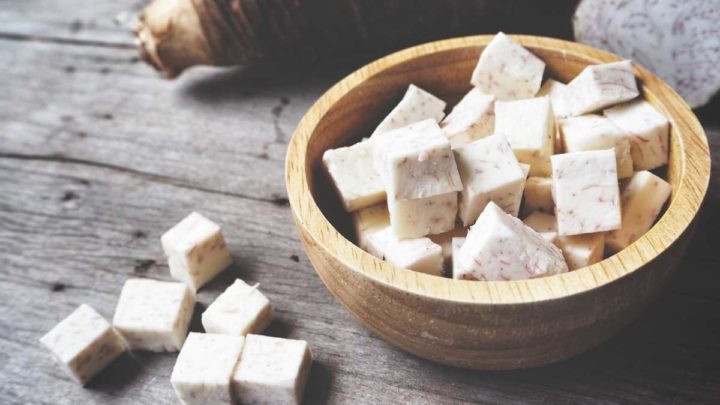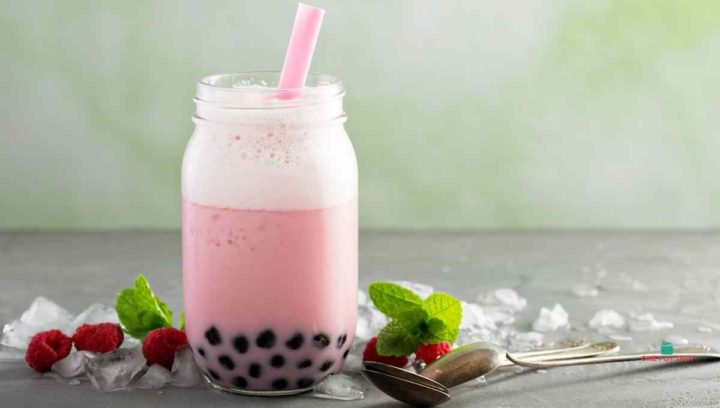What Does Taro Taste Like
How would you describe the taste of taro?
Taro flavor tastes like a cross between sweet potato and pumpkin which makes it perfect for one of its favorite uses – that is making Taro Bubble Tea.
It is very similar to the flavor of yams, but it has more sweetness than any other root vegetable. Some people also taste a slight nuttiness as well, which again just adds to its appeal when making a nice milky tea.
What Does Taro Root Taste Like?
The flavor of taro root or vegetable is similar to sweet potato, but with a slightly nutty aftertaste. It has a light sweetness and a smooth texture, making it perfect for drinking hot or cold.
You May Also Be Interested In
How Does Taro Bubble Tea Taste Like?
Taro Bubble Tea has a mild sweetness from the natural sugars found in the taro root.
As Taro is a mildly sweet vegetable often a tea-like Jasmine is mixed in giving it a calming flavor.
It is better described as a sweet, smooth-tasting drink.
You can also use Taro Powder, which is often used in boba flavored tea.
Taro powder taste
The Powdered Taro is hardly ever eaten alone. It tastes a little sweet but also starchy. Better that you use it in a recipe rather than eating it by itself.

Taro Boba Tea Taste
The texture of this drink is similar to that of regular bubble teas but without the sugar. It has a slightly sweet flavor from the jasmine tea base and the milk. I love making this because it’s super simple to make and doesn’t require any special equipment.
What Is the Texture of Taro Bubble Tea
Using Taro to manufacture your favorite tea gives you a rich creamy texture which also comes from the starchy base of natural taro. We must also not forget the boba – or to call them by their other name Tapioca Pearls (see Tapioca flour alternatives). This addition to the hot or cold drink gives a dessert-like body texture to the “Tea of Bubble”
How is Taro Bubble Tea Made?
The first step is to boil water in a large pot. Once boiling, add the jasmine tea leaves and let them infuse into the hot water for 10 minutes. Next, pour the brewed tea through a strainer and discard the tea leaves. Add the milk and stir well. Finally, add the tapioca pearls and mix well. Serve immediately.
See the video of how to make it.
How To Make Taro Bubble Tea?
- start by taking 2 ounces of taro powder, 1.5 tbs white sugar, and 6 oz of milk
- Stir and mix
- Add 1 cup ice cubes and tapioca pearl to your desire or taste
- Boil 5 cups of water in a pot
- To the pot add the tapioca pearl and sugar.
- Stir each minute for 5 minutes
- Cleans the pearls by draining and then rinsing under cool water
- Add all except the pearls to a blender and mix
- Pour into cups leaving room to add the tapioca pearls.
What Is the Difference Between Taro Powder and Taro Vegetable Root
The main difference between Taro Root Vegetable vs Powder is that the powder is so much easier to use (and to purchase and store). The tastes are similar to what you would expect.
You may come across many preparations to make taro bubble tea, many of which utilize taro flavored powder and others that use genuine taro vegetable root, and question which one to use. Taro powder is used in this dish for numerous reasons:
To begin, when you order taro boba tea out of a bubble tea shop, this powder is used to produce it (normally or unless it says otherwise). Using the powder instead of the root results in a more “genuine” taste of milk tea. Essentially, this variant will flavor more like the type you’re accustomed to purchasing from a bubble tea shop.
Using the powder is so much easier and quicker! Using a powder instead of frying the taro root saves a lot of time.
Taro powder is simpler to get by than raw vegetable taro root. Both are available in local Asian grocery shops, although not everyone lives near one. Those who aren’t may easily get taro powder online.
Is Taro Healthy?
Taro is a starchy root vegetable native to China, Taiwan, Japan, and Southeast Asia. It has long been used in Chinese medicine to promote digestion and reduce inflammation. The health benefits of this sweet tuber include lowering cholesterol levels, improving blood sugar control, reducing the risk of heart disease, and boosting immunity.

Why is the Taro Tea Purple?
The purple color comes from the addition of food color to the taro powder. which gives the drink its signature purplish tint.
Often there is a small amount of Turmeric added which also has anti-inflammatory properties.
Is Taro Bubble Tea Vegan?
No, as it usually has milk or milk powder added.
However, there are many Organic Shops that offer a huge amount of taro bubble tea recipe varieties like gluten free, soy free, dairy free, egg free, nut free, GMO free, refined sugar free, artificial sweetener free and preservative free.
In summary, taro is one of my favorite vegetables! I love how versatile it is and what it adds to dishes. If you haven’t tried taro yet, give it a try today!
What is Taro Milk Tea
It’s a simple recipe that takes less than 30 minutes to prepare and sometimes even has a small amount of condensed milk added to it.
The best part is that you don’t need any special equipment to make this delicious drink. All you need is a blender and a few ingredients.

How To MakeTaro Milk Tea or Taro Bubble Tea Healthier
The best part of this drink is that you need standard kitchen equipment to make it. All you need is a blender and some ingredients. If you want to make this dish healthier, you can replace the sugar with stevia or honey.
What are the Health Benefits of Taro Root?
Taro root has many health benefits, including being high in fiber, potassium, vitamin C, calcium, iron, magnesium, phosphorus, copper, zinc, manganese, folate, thiamine, riboflavin, niacin, pantothenic acid, biotin, and vitamins A and B6. It also contains lignans, which may protect against breast and prostate cancers.
How Do You Eat Taro Root?
The best way to eat this delicious root vegetable is by boiling it first. Then, you can enjoy it plain, stir-fried, or added to soups and stews.
How Is Taro Root Eaten?
The leaves of this plant are used to make tea, but they are also eaten raw. They taste similar to spinach and are often added to stir-fries. In Japan, where this plant originated, the leaves are often steamed before eating.

What Does the Texture of Taro Root Taste Like?
What is the texture of taro root-like? – The structure or texture is very similar to an Idaho potato. Potatoes are used as a building block for a dish and so can the taro root be used as a foundation of a dish. In addition, they have smooth skin that makes them easy to peel. The flesh inside is firm with no soft spots. This means you will need to cut up your taro before cooking if you want to use it whole in recipes.
What Does Raw Taro Taste Like?
Raw taro tastes like a slightly sweeter version of potatoes. You may notice some hints of nuts when eating raw taro. They do not contain much starch which gives them their characteristic crunchy texture. When cooked, this texture changes into something softer and smoother.
What Does Cooked Taro Taste Like
– Taro is a starchy root vegetable that has a sweet taste or flavor. It’s often used as a substitute for potatoes or rice.
– Taro is also known as the Chinese potato because it was introduced to China during the Tang Dynasty.
– Taro comes in many different varieties, including purple, white, yellow, red, and green.
What Does Taro Ice Cream Taste Like?
Taro ice cream tastes like a combination of vanilla ice cream and caramelized sugar.

What Does Taro Mochi Taste Like
Taro mochi tastes like sweet potato with a little bit of saltiness. Furthermore, it is very sticky and chewy.
What Does Tapioca Feel Like?
Tapioca feels like a mixture of cornstarch and tapioca flour. You can buy these flours separately or mix them together yourself.
What Does a Taro Smoothie Taste Like
A taro smoothie tastes like a mixture of banana and taro.
How Do You Cook Taro Root?
You cook taro just like potatoes. They both take about 20 minutes at 400 degrees Fahrenheit until tender when pierced with a fork.
- Start by preheating your oven to 400F.
- Wash the taro then peel and slice it with a sharp knife into 1/4 inch slices
- Drizzle vegetable oil on both sides of the sliced taro.
- On a baking tray lay them on parchment paper
- season with salt
- Bake for10 minutes for each side watching for when they turn to a golden crisp.
- Take them out and season with a dash of pepper or even cayenne pepper and serve.
What Does Baked Taro Taste Like
Baked taro tastes like a semi-sweet potato and has a similar texture. depending on the age of the Taro you may get earthy or nutty undertones of flavor also. The older the Taro the more dietary fiber.
What does Steamed Taro Taste Like
Steamed taro tastes like sweet potato with a hint of bitterness.
Taro can be eaten raw or cooked in many different ways. The most common way to eat this delicious tuber is by steaming them with butter and salt for about 20 minutes until tender. You may also boil them whole or cut into cubes and then steam them.
What tastes similar to taro
Taro tastes like sweet potato, yams or even like some varieties of squash, depending on how it is prepared. Ube taste, texture, and flavor is also often compared to taro.
What does purple taro taste like
Purple taro tastes like sweet potato with a hint of sweetness, cinnamon or nutty tang. Some people call it a purple yam.
Does Taro Taste Like Coconut
No, it does not, although coconut is often used with taro as a dessert.
Does Taro Taste Like Meat
It doesn’t but it does have a slight savory flavor.
Summary of Taro and its taste.
1. Taro is a starchy root vegetable that tastes like a cross between potato and yam.
2. It’s grown in Hawaii.
3. The leaves are used to wrap sushi.
4 You can eat it raw, boiled, baked, fried, mashed, or even made into chips.
5. It’s a staple food in Japan.
6. In Hawaii, it’s called “taro root.”
7. It’s also known by other names such as “yautia” and “batata.”
Conclusions about Taro
Taro is a popular vegetable in Japan. It has a unique flavor and texture. It’s also known as the Chinese potato.
Taro is an excellent source of vitamin A, B6, C, E, K, magnesium, phosphorus, potassium, zinc, copper, iron, manganese, niacin, pantothenic acid, riboflavin, thiamine, folate, and fiber.
Taro is also rich in antioxidants such as beta carotene, lutein, zeaxanthin, lycopene, alpha-carotene, and phytoene.
Taro is high in dietary fiber, protein, carbohydrates, and fat.
However, Taro is most well know in Taro bubble Tea!